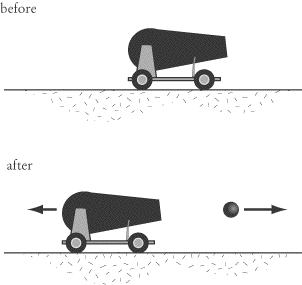Torque * rps > = Mass * Acceleration * Velocity / (2 * pi)
RMF = Torque * rps
Check out the user friendly RMF Calculator, or my outdated excel sheet for calculating RMF.
1)To use this equation, look up a set of motors you think will work for yourrobot and write down the torque and rps (rotations per second) for each.
2)Then multiply the two numbers together for each. This will be your robot motorfactor.
3)Next, estimate the weight of your robot. Basically add up the weight of all theparts.
4)Lastly, choose your desired velocity and acceleration.
5)Compare both sides of the equation
Example.Suppose you found three motors:
Motor A: 2 lb ft, 1rps => RMF = 2 lb ft rps
Motor B: 2.5 lb ft, 2rps => RMF = 5 lb ft rps
Motor C: 2 lb ft, 4rps => RMF = 8 lb ft rps
Motor A: 2 lb ft, 1rps => RMF = 2 lb ft rps
Motor B: 2.5 lb ft, 2rps => RMF = 5 lb ft rps
Motor C: 2 lb ft, 4rps => RMF = 8 lb ft rps
Nowsuppose you want a velocity of 3 ft/s, an acceleration of 2 ft/s^2, and youestimate your robot weight to be 5 lbs.
so RMF >= 5 lbs * 2 ft/s^2 * 3 ft/s / (2 * pi)
therefore RMF >= 4.77 lb * ft * rps
Sothis means you need a motor with an RMF greater or equal to 4.77. Looking atyour list, Motor B and C both will work. However Motor C is probably overkill,so it's just a waste of money. Therefore you would use Motor B. Just note thatif none of the motors would work, you would have to either reduce weight, or goslower, or find another motor.
note:if you convert rps to radians/sec, RMF can be measured in watts
So now what robot wheel diameter should you use? Going backto an earlier equation,
velocity = diameter * pi* rps
OR
diameter = velocity / (pi * rps)
OR
diameter = velocity / (pi * rps)
3 ft/s / (pi * 2/s) =wheel diameter = .48 feet = 5.73"
You are finished! You use motor B,with a wheel diameter of 5.73", and never again will your robot fail atplowing over the neighborhood cat.
Although the above equations areintended for robot wheels, they will also work for any other robot part. If youwere say designing a robot arm,instead of using diameter use robot arm length. Then you can calculate how fastthe arm will move with a certain weight being carried, for example.

The RMF you calculated is only for a 100% efficient system. But in reality thisnever happens. Gearing andfrictionand many other factors cause inefficiency. I won't go into how to calculateefficiency, but there are general rules that would get you really close. If youhave external (not inside the motor) gearing, reduce your efficiency by ~15%.If you are using treads like on a tank robot, reduce by another ~30%. If yourrobot operates on rough high friction terrain, reduce another ~10%. Forexample, a tank robot on rough terrain would have an efficiency of (100% - 30%)*(100%- 10%) = 63% or 0.63.
The RMF equation, incorporatingefficiency, is
Torque * rps > = Mass* Acceleration * Velocity * (1/efficiency) / (2 * pi)
where efficiency is a percentageexpressed as a decimal number (i.e. 80% = .8).
Again, check out the user friendly RMF Calculator, or my outdated excel sheet for calculating RMF.

Ever notice how heavier things are harder to push than lighter things? This isbecause of momentum. Knowing your robot's momentum is very important if youwant high acceleration for your robot. If your robot is heavy, it will takeforever for a weak motor to get it to go fast. How do you determine themomentum of your robot? Just multiply the mass times the velocity. Lowermomentum is better for mobility and higher energy efficiency. Higher momentumis better for beating up other robots . . . and people.
Momentum = Mass * Velocity
No comments:
Post a Comment